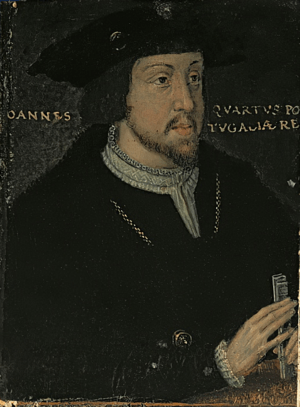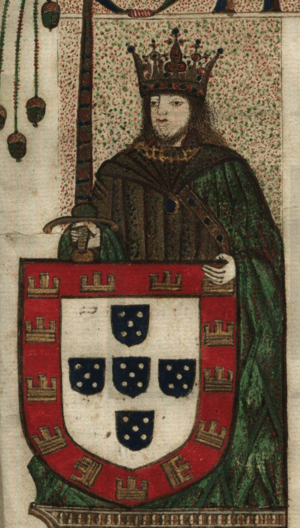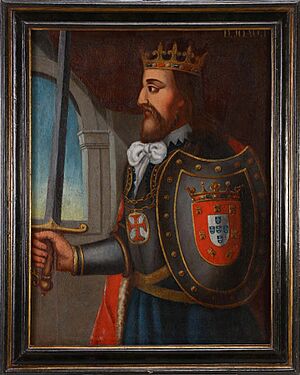John II of Portugal facts for kids
Quick facts for kids John II |
|
|---|---|

Portrait of John II made in the 16th century
|
|
| King of Portugal (more...) | |
| Reign | 28 August 1481 – 25 October 1495 |
| Acclamation | 31 August 1481, Sintra |
| Predecessor | Afonso V |
| Successor | Manuel I |
| Reign | 11 November 1477 – 15 November 1477 |
| Acclamation | 11 November 1477, Santarém |
| Predecessor | Afonso V |
| Successor | Afonso V |
| Born | 3 March 1455 Saint George's Castle, Portugal |
| Died | 25 October 1495 (aged 40) Alvor, Algarve |
| Burial | Monastery of Batalha |
| Spouse | |
| Issue detail... |
Afonso, Prince of Portugal George of Lencastre (illegitimate) Brites Anes de Santarém (illegitimate) |
| House | Aviz |
| Father | Afonso V of Portugal |
| Mother | Isabella of Coimbra |
| Religion | Roman Catholicism |
John II (born March 3, 1455 – died October 25, 1495) was a powerful King of Portugal. He was sometimes called "the Perfect Prince". He ruled from 1481 until his death in 1495, and also for a short time in 1477. King John II is famous for making the Portuguese monarchy strong again. He also helped the Portuguese economy grow and restarted Portugal's explorations in Africa and Asia.
Contents
Early Life of King John II
John II was born in Lisbon. His father was King Afonso V of Portugal, and his mother was Isabella of Coimbra. John became ruler of Portugal in 1477 when his father retired. However, he officially became king in 1481 after his father passed away.
As a young prince, John II joined his father in battles in northern Africa. He became a knight after a victory in Arzila in 1471. In 1473, he married Leonor of Viseu, who was his first cousin.
Even when he was young, John was not very popular with the nobles. He didn't let others influence him and seemed to dislike their plotting. The nobles, especially his cousin Ferdinand II, Duke of Braganza, worried about his future plans as king.
How John II Gained Power
After becoming king in 1481, John II took steps to reduce the power of the nobles. He wanted to make sure all power was with him. For example, he took away their right to make legal decisions on their own lands.
The nobles quickly started to plan against him. The Duke of Braganza and Queen Isabella I of Castile exchanged letters complaining about the king. King John was careful. He made sure his son Afonso was safe at court before acting against Braganza.
In 1483, royal spies found more secret letters. The House of Braganza was declared illegal, their lands were taken, and the duke was executed in Évora. The duke's wife, Isabella of Viseu, who was John's cousin, fled to Castile with her children.
The next year, the Duke of Viseu, John's cousin, was called to the palace. The king himself stabbed him to death because he suspected a new plot. Many others were executed, murdered, or sent away to Castile. This included the Bishop of Évora, who was poisoned in prison. After these strong actions, no one dared to challenge the king. John II faced no more plots during his rule. The crown took over many lands, which made the king the most powerful person in the kingdom.
Portugal's Economy Under John II
When John II became king, Portugal was almost bankrupt. He decided to fix this by creating a special council of smart people. The king chose members for this council based on their skills and talents. This meant that people were chosen for their abilities, not their family name.
John's plans for exploration also brought in a lot of money. The profits from his investments in overseas trips were so great that Portugal's money became the strongest in Europe. The kingdom could finally use taxes for its own needs instead of paying off debts. This was mostly thanks to the gold coming from the coast of Guinea.
Portuguese Exploration and Discoveries
John II famously brought back the idea of exploring the Atlantic Ocean. He continued the work of his great-uncle, Henry the Navigator. Portuguese explorations were his main goal as king. Portuguese explorers sailed south along the coast of Africa. Their aim was to find a sea route to India and join the valuable spice trade.
During his reign, these important things happened:
- 1482: The fortress and trading post of São Jorge da Mina was built on the coast.
- 1484: Diogo Cão discovered the Congo River.
- 1488: Bartolomeu Dias found and sailed around the Cape of Good Hope in Mossel Bay.
- 1493: Álvaro Caminha began settling the São Tomé and Príncipe islands.
- He paid for land trips by Afonso de Paiva and Pêro da Covilhã. They went to India and Ethiopia looking for the kingdom of Prester John.
Some historians believe that Portugal kept some of its explorations secret. This was to prevent other countries, like Castile, from competing. Many old records from this time were lost. Some were destroyed in the 1755 Lisbon earthquake or during the Peninsular War.
Conflict with Castile and the Treaty of Tordesillas
When Christopher Columbus returned from his first voyage in early 1493, he first stopped in Lisbon. He wanted to tell King John II about his discoveries. King John II said that Columbus's discoveries were in Portugal's area. This was based on the Treaty of Alcáçovas signed earlier with Spain.
Before Columbus even reached Isabella I of Castile, John II sent a letter. He threatened to send a fleet to claim the new lands for Portugal. Spain quickly agreed to talk. The meeting happened in a small Spanish town called Tordesillas. A representative from the Pope was there to help. The result of this meeting was the famous Treaty of Tordesillas. This treaty aimed to divide all newly found lands in the New World between Spain and Portugal.
John II's Legacy
John II died in Alvor at age 40. He did not have any children who could legally inherit the throne. He tried to make his son Jorge, Duke of Coimbra, his successor. However, he was succeeded by his first cousin and brother-in-law, Manuel I.
His nickname, "the Perfect Prince" was given to him after his death. It refers to Niccolò Machiavelli's book The Prince. Many believed John II lived his life exactly like Machiavelli's idea of a perfect prince. He was admired as one of the greatest European kings of his time. Isabella I of Castile often called him "El Hombre" ("The Man").
An Italian scholar named Poliziano wrote a letter praising John II. He said John's achievements were even greater than those of Alexander the Great or Julius Caesar. Poliziano offered to write a long poem about John II's explorations and conquests. The king replied positively in 1491 but delayed the project.
Family and Children
| Name | Birth | Death | Notes |
|---|---|---|---|
| By Leonor of Viseu (married in January 1471) | |||
| Infante Afonso | May 18, 1475 | July 13, 1491 | Prince of Portugal. He died in a horse riding accident. Because he died young, the throne went to Manuel of Viseu, Duke of Beja. Manuel became King Manuel I. |
| Stillborn | 1483 | 1483 | A son who was stillborn in 1483. |
| By Ana de Mendonça | |||
| Jorge | August 21, 1481 | July 22, 1550 | His natural son, known as Jorge de Lancastre, Duke of Coimbra. |
| By Brites Anes | |||
| D. Brites Anes de Santarém | c. 1485 | ? | Married João Pires Amado. |
See also
 In Spanish: Juan II de Portugal para niños
In Spanish: Juan II de Portugal para niños



